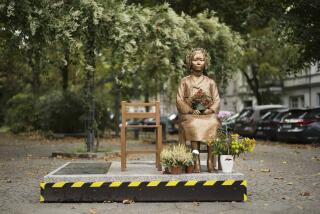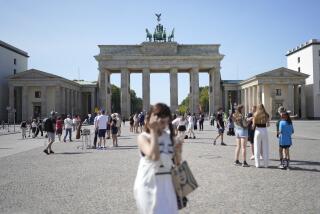East Germany Is Gone, but the Kitsch Lives On
BERLIN — In a country that is no more, there were cars missing parts, cranky washing machines, endless slabs of look-alike apartment buildings, billows of barbed wire, a cartoon character called the junkman and guys playing chess in the nude.
The former East Germany vanished in the dust and shattered graffiti of a falling Berlin Wall. A Cold War counterbalance to democracy, the German Democratic Republic excelled at bureaucrats, double agents and Olympic athletes who clattered with medals of bronze, silver and gold.
The quiet lives and kitschy accoutrements that existed in this totalitarian crucible are at the center of Berlin’s new GDR Museum. It is a curious mix of nostalgia and political history that concentrates less on East Germany’s brutality, such as its secret police and prisons, and more on the grist of everyday life: tiny Trabant cars, thick upholstered couches, Solotov vodka, Rondo coffee and mind-bending euphemisms.
Located along the River Spree, not far from an abysmal heap of communist architecture known as the Palace of the Republic, the museum is marketed more to tourists than academics. Water taxis coast past and suspicious vendors selling Russian army hats and East German military insignia keep an eye peeled for police.
Five hundred people donated more than 10,000 items to the museum, much of it mementos and musty trinkets that seem pulled from basements and shoeboxes. One meticulous woman left a diary from 1984 that lists the things her nation sometimes went without, such as handles on the doors to toilets. She chronicles the fate of an unfortunate man, described only as Peter, who couldn’t “get a bridge for his teeth for lack of material.”
Museum director Robert Rueckel said: “People want to see the real GDR, the real history. East Germany disappeared very fast after the wall fell. The exhibit wants to take you into the life of the GDR. It was a country of good things and bad things, and the hand of the state was never far away. Some historians have criticized us for glorifying the GDR. But we’re looking at all parts of it for a fuller picture.”
Remembrances and horrors of the Nazis and the Communists are parsed and studied here, part of a perpetual German preoccupation with identity in a once divided land. Even today, with Berlin’s emergence as a formidable global voice, many in eastern Germany, facing shrinking social programs and jobless rates as high as 25%, believe life was more secure under communism.
The GDR Museum is another wrinkle in that debate. It is a cursory glimpse of a nation that hawked matryoshka knickknacks and referred to the Berlin Wall as “the anti-fascist protective wall.” Because the word “jeans” had a Western aura reviled by the Stasi secret police, dungarees manufactured in East Germany were called “blue cottino trousers.” A pair of Levis, often referred to in mythic terms by regular East Germans, could be bought on the black market or at an Exquisit shop for 275 marks -- about one-third of a monthly income.
An East German who wanted a car most likely waited years for a boxy Trabant to wobble off the assembly line. First produced in the late 1950s, this icon of the East and epitome of delusion was meant to “compete with the successful Western Beetle.” The museum exhibit notes: “In accordance with the engineers’ motto -- fewer parts mean less trouble -- the Trabi didn’t even have a cooling loop.”
The boogeyman was the fascist. He was to be feared and crushed. In an elementary school workbook from 1976, a girl writes in careful cursive that “we will learn diligently and behave in a disciplined way ... and learn about life and the fight of the anti-fascists.”
With a state security ministry of 93,000 employees and 173,000 collaborators, East Germany convicted 250,000 people of political crimes.
Phones were tapped, eavesdropping was a sinister art form, and citizens were told to pay more attention to Helga Hahnemann and her TV variety show than the scurrilous punk movement that reverberated from the underground.
When things got too dour, there was always Olympic figure skater Katarina Witt pirouetting across the ice, or the catchy songs of the Puhdys rock band. Vacation destinations were other drab communist haunts, such as Warsaw, Budapest and, of course, Moscow.
Political repression sometimes led to freedom in other areas. Perhaps in keeping with the Romantic Movement of the late 18th and early 19th centuries, which extolled the spirit’s uninhibited joy for nature, East Germans did a lot of things in the buff: tennis, gardening, rafting, volleyball and hiking, to name just a few. The museum has what some might consider an overly thorough collection of pictures and video of these activities.
There were plenty of birth control pills, sex education books and the prattling of Karl Eduard von Schnitzler, a television commentator with thick glasses and a grave demeanor whose soliloquies chastised the West for “mixing into our affairs.” Children had to make do with fictional characters such as Rumpelmaennchen, a white-bearded junkman with a walking stick whose favorite topic was conservation.
A woman strolling through the replica of a typical East German apartment said, “There used to be a joke in the East that you could mistakenly stumble drunk into somebody else’s apartment at night and find your way around because all the apartments were laid out the same.”
Such asides seem quaint reflections on a nation that was once stitched into a Soviet bloc with a nuclear arsenal that had the capability to destroy much of the world. Its symbols are fading; the wrecking cranes are bringing down the Palace of the Republic and foreign investors are buying up long stretches of apartment blocks.
One of the more telling snippets in the museum is an exchange between then-East German leader Erich Honecker and the director of a porcelain factory in Meissen. At the time, the country was trying to export as much as it could, leaving the leftovers to its people.
The director proudly tells Honecker, “Five percent of our production are rejects.” Honecker replies, “Is that enough for the whole country?”
More to Read
Sign up for Essential California
The most important California stories and recommendations in your inbox every morning.
You may occasionally receive promotional content from the Los Angeles Times.











